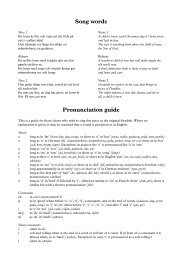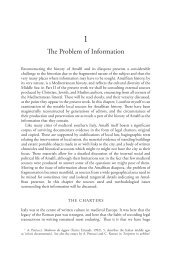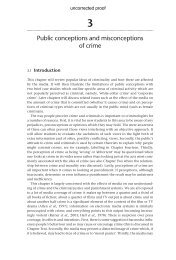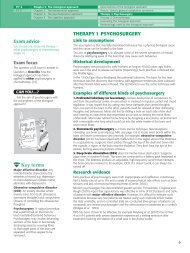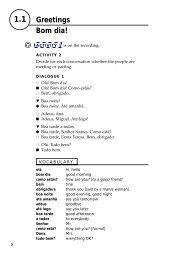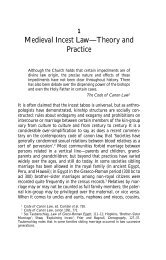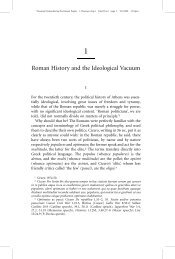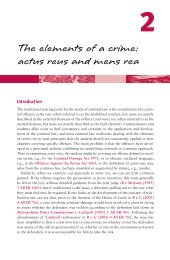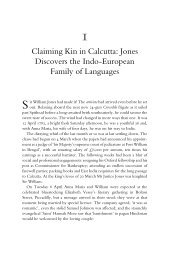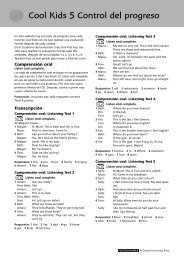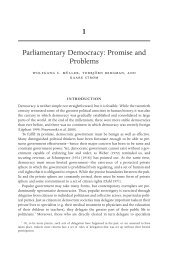Temperature (1) - Oxford University Press
Temperature (1) - Oxford University Press
Temperature (1) - Oxford University Press
Create successful ePaper yourself
Turn your PDF publications into a flip-book with our unique Google optimized e-Paper software.
Q<br />
Additional fixed points<br />
Although the ice and steam points are sufficient to create a<br />
scale over the range required for everyday temperature<br />
measurements, there are additional fixed points for much<br />
higher and lower temperatures. You can see some examples<br />
on the right. For simplicity, the temperatures are given to the<br />
nearest degree. In practice, greater accuracy is used.<br />
Liquid-in-glass thermometers<br />
Nearly all liquids expand slightly when heated. This property is used in<br />
liquid-in-glass thermometers, which are normally filled with alcohol or mercury.<br />
Sensitivity Some thermometers are more sensitive to temperature change<br />
than others. The ‘thread’ of liquid moves further. The diagrams on the right<br />
show how tube width affects the sensitivity. The narrower the tube, the higher<br />
the sensitivity of the thermometer.<br />
Mercury expands less than alcohol (for the same volume and same<br />
temperature rise). So a mercury thermometer must have a narrower tube than<br />
an alcohol thermometer to give the same sensitivity.<br />
Range Mercury freezes at �39 �C; alcohol freezes at a much lower<br />
temperature, �115 �C. However, some mercury thermometers have an upper<br />
limit of 500 �C, which is much higher than that of any alcohol thermometer.<br />
Responsiveness Some thermometers respond more quickly to a change in<br />
temperature than others. A thermometer with a larger bulb, or thicker glass<br />
round the bulb, is less responsive because it takes longer for the alcohol or<br />
mercury to reach the temperature of the surroundings.<br />
Linearity Although mercury and alcohol thermometers must agree at the<br />
fixed points, they do not exactly agree at other temperatures. That is because<br />
the expansion of one liquid is not quite linear compared with the other.<br />
However, within the 0�100 �C range, the disagreement is very small.<br />
Thermocouple thermometer<br />
For a diagram and brief description, see the previous spread, 5.02. Compared<br />
with a liquid-in-glass thermometer, a thermocouple thermometer is robust,<br />
quick to respond to temperature change, has a wide range (�200 �C to<br />
1100 �C), and can be linked to other electrical circuits or a computer.<br />
1 The thermometer on the right has the ice and steam points marked on it.<br />
a On the Celsius scale, what is the temperature of<br />
i the ice point ii the steam point?<br />
b What is the temperature reading in �C, if the end of the ‘thread’ is at<br />
i point A ii point B iii point C?<br />
c Explain why reading C would not be possible with a mercury thermometer.<br />
2 A – smaller bulb B – thicker glass round bulb C – thinner tube<br />
For a liquid-in-glass thermometer, which of the above would<br />
a increase the sensitivity? b increase the responsiveness?<br />
Related topics: standard atmospheric pressure 3.08<br />
THERMAL EFFECTS<br />
Fixed point <strong>Temperature</strong><br />
boiling point of liquid oxygen �183 �C<br />
freezing point of molten (liquid) zinc 420 �C<br />
freezing point of molten (liquid) silver 962 �C<br />
freezing point of molten (liquid) gold 1064 �C<br />
steam point<br />
same<br />
volume<br />
of liquid<br />
alcohol<br />
lower temperature<br />
same<br />
increase<br />
in volume<br />
of liquid<br />
alcohol<br />
higher temperature<br />
� The narrower the tube, the further<br />
the liquid moves up it when the<br />
temperature rises.<br />
ice point<br />
A<br />
B<br />
C<br />
cm<br />
30<br />
20<br />
10<br />
0<br />
!<br />
103




